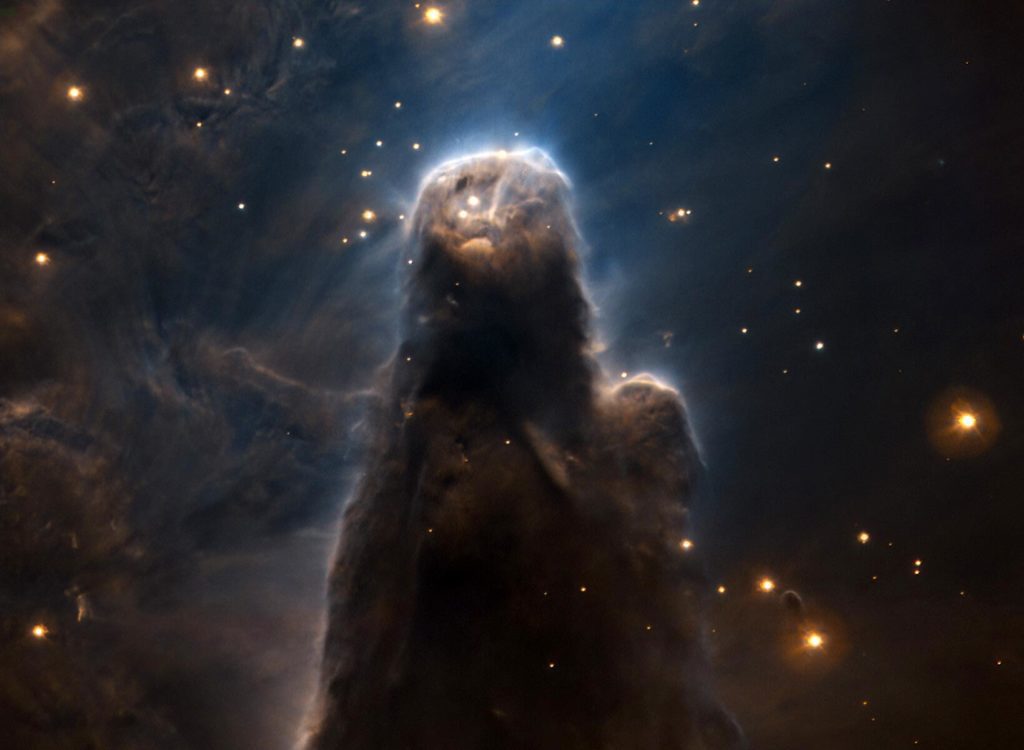
Der Kegelnebel ist Teil einer Sternentstehungsregion im Weltraum, NGC 2264, etwa 2500 Lichtjahre entfernt. Sein säulenartiges Aussehen ist ein perfektes Beispiel für die Formen, die zu riesigen Wolken aus kaltem molekularem Gas und Staub heranwachsen können, die dafür bekannt sind, neue Sterne zu erschaffen. Diese spektakuläre neue Ansicht des Nebels wurde mit dem FOcal Reducer und dem Instrument Low Dispersion Spectrograph 2 (FORS2) am Very Large Telescope (VLT) der ESO aufgenommen und anlässlich des 60. Jahrestages des Nebels veröffentlicht. Bildnachweis: ESO
Ein wunderbares Bild von Star Factory markiert 60 Jahre Zusammenarbeit
Seit 60 Jahren ist die Europäische Südsternwarte ([{“ attribute=““>ESO) has been enabling scientists worldwide to discover the secrets of the Universe. They mark this milestone by bringing you a spectacular new image of a star factory, the Cone Nebula, taken with ESO’s Very Large Telescope (VLT).
Five countries signed the convention to create ESO on October 5, 1962. Now, six decades later and supported by 16 Member States and strategic partners, ESO brings together scientists and engineers from around the world to develop and operate advanced ground-based observatories in Chile that enable breakthrough astronomical discoveries.
On the occasion of ESO’s 60th anniversary, they released this remarkable new image of the Cone Nebula, captured earlier this year with one of ESO’s telescopes and selected by ESO staff. This is part of a campaign marking ESO’s 60th anniversary and taking place in late 2022, both on social media under the #ESO60years hashtag, and with local events in the ESO Member States and other countries.
Dieses Video beginnt an unserem Standort in der Galaxie und zeigt das staubige Sternband der[{“ attribute=““>Milky Way. Zooming in towards it, we move to the constellation Monoceros (The Unicorn), next to Orion, where the large star-forming region of the NGC 2264 cluster can be found. Within this cluster, we find the pillar-like shape of the Cone Nebula. The dramatic new view of the nebula shown at the end of the video, showcases its dark and impenetrable cloudy appearance. The image was captured with the FOcal Reducer and low dispersion Spectrograph 2 (FORS2) instrument on ESO’s Very Large Telescope (VLT), and was released on the occasion of ESO’s 60th anniversary. Credit: ESO/L.Calçada, ESO/Digitized Sky Survey 2. Acknowledgment: D. De Martin. Music: Azul Cobalto
In this new image, the seven-light-year-long pillar of the Cone Nebula is center-stage, This is part of the larger star-forming region NGC 2264 and was discovered in the late 18th century by astronomer William Herschel. In the sky, this horn-shaped nebula is found in the constellation Monoceros (The Unicorn), a surprisingly fitting name.
Located less than 2500 light-years away, the Cone Nebula is relatively close to Earth, making it a well-studied object. However, this view is more dramatic than any obtained before, as it showcases the nebula’s dark and impenetrable cloudy appearance in a way that makes it resemble a mythological creature.

This image from the Digitized Sky Survey (DSS) shows the region of the sky around the Cone Nebula. The nebulous area at the center of the image is NGC 2264, an area of the sky that includes the Christmas Tree star cluster and the Cone Nebula below it (at the very center of the frame). Credit: ESO/Digitized Sky Survey 2, Acknowledgment: D. De Martin
The Cone Nebula is a perfect example of the pillar-like shapes that develop in the giant clouds of cold molecular gas and dust, known for creating new stars. This type of pillar arises when massive, newly formed bright blue stars give off stellar winds and intense ultraviolet radiation that blow away the material from their vicinity. As this material is pushed away, the gas and dust further away from the young stars get compressed into dense, dark, and tall pillar-like shapes. This process helps create the dark Cone Nebula, pointing away from the brilliant stars in NGC 2264.
In this image, obtained with the FOcal Reducer and low dispersion Spectrograph 2 (FORS2) on ESO’s VLT in Chile, hydrogen gas is represented in blue and sulfur gas in red. The use of these filters makes the otherwise bright blue stars, which indicate recent star formation, appear almost golden, contrasting with the dark cone-like sparklers.

This chart shows the location of the Cone Nebula in the constellation Monoceros (The Unicorn), in red. The map shows most of the stars visible to the unaided eye under good conditions. Credit: ESO, IAU and Sky & Telescope
This image is just one example of the many stunning and awe-inspiring observations ESO telescopes have made in the past 60 years. While this one was obtained for outreach purposes, the overwhelming majority of ESO’s telescope time is dedicated to scientific observations that have allowed them to capture the first image of an exoplanet, study the black hole at the center of our home galaxy, and find proof that the expansion of our Universe is accelerating.
Building on their 60 years of experience in astronomy development, discovery, and cooperation, ESO continues to chart new territory for astronomy, technology, and international collaboration. With our current facilities and ESO’s upcoming Extremely Large Telescope (ELT), we will keep on addressing humanity’s biggest questions about the Universe and enabling unimaginable discoveries.
More information
The image in this release was created as part of the ESO Cosmic Gems program, an outreach initiative to produce images of interesting, intriguing or visually attractive objects using ESO telescopes, for the purposes of education and public outreach. The program makes use of telescope time that cannot be used for science observations. All data collected may also be suitable for scientific purposes, and are made available to astronomers through ESO’s science archive.

Freiberuflicher Alkoholiker. Begeisterter Webfanatiker. Subtil charmanter Zombie-Junkie. Ergebener Leser.
You may also like
-
Österreichische Gletscher ziehen sich „mehr denn je“ zurück: Messung
-
Von der NASA ins All geschickte Samen, Forstdienst kehrt zur Erde zurück und erschafft eine neue Generation von „Mondbäumen“
-
Wie die Vereinigten Arabischen Emirate ein Raumschiff zum Mars schickten – beim ersten Versuch
-
Die seltensten Wolken der Welt erscheinen über der Bucht von San Francisco
-
2023: Massive Menschenmassen in Abuja, als APC-Frauen und -Jugendliche eine Kundgebung für die Präsidentschaft von Tinubu/Shettima abhalten

